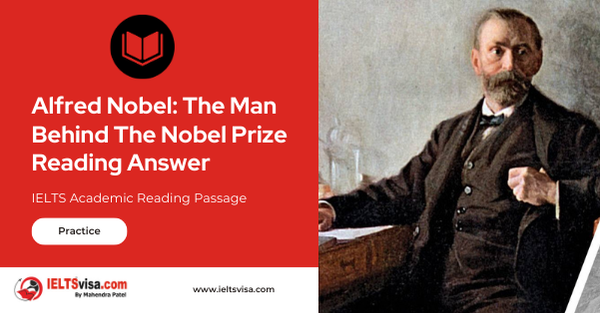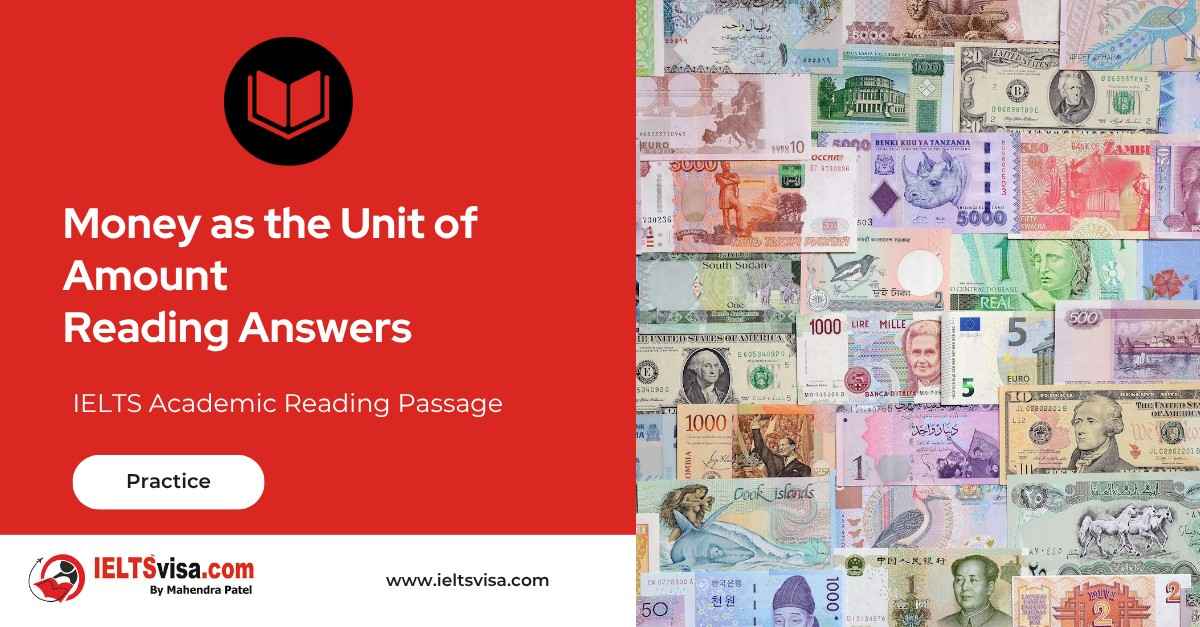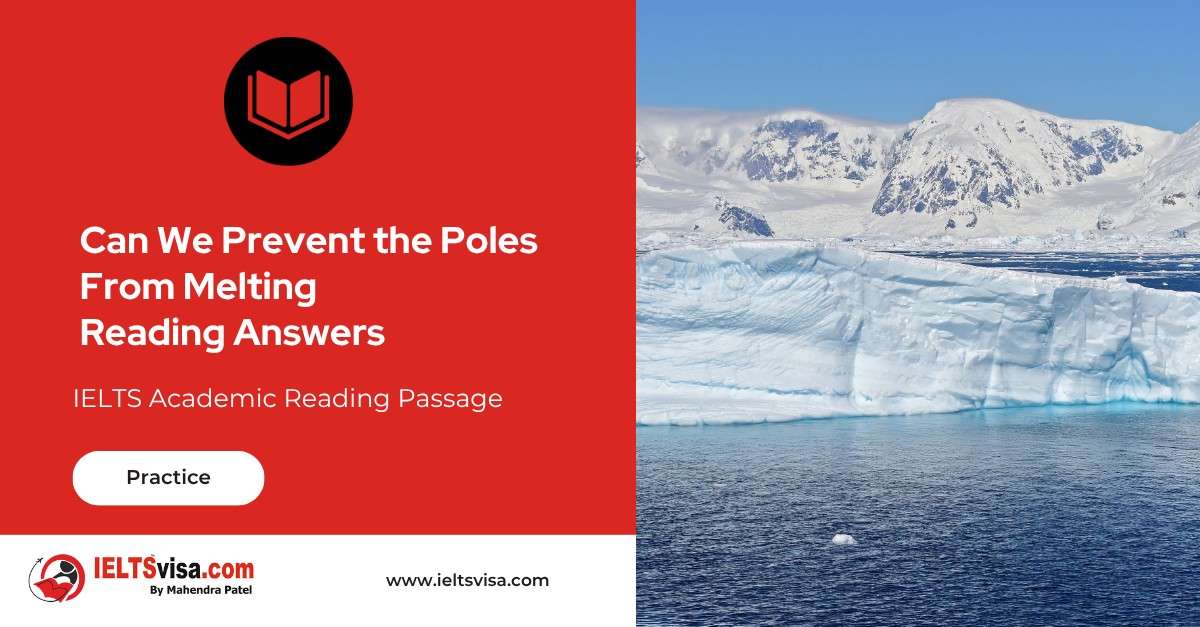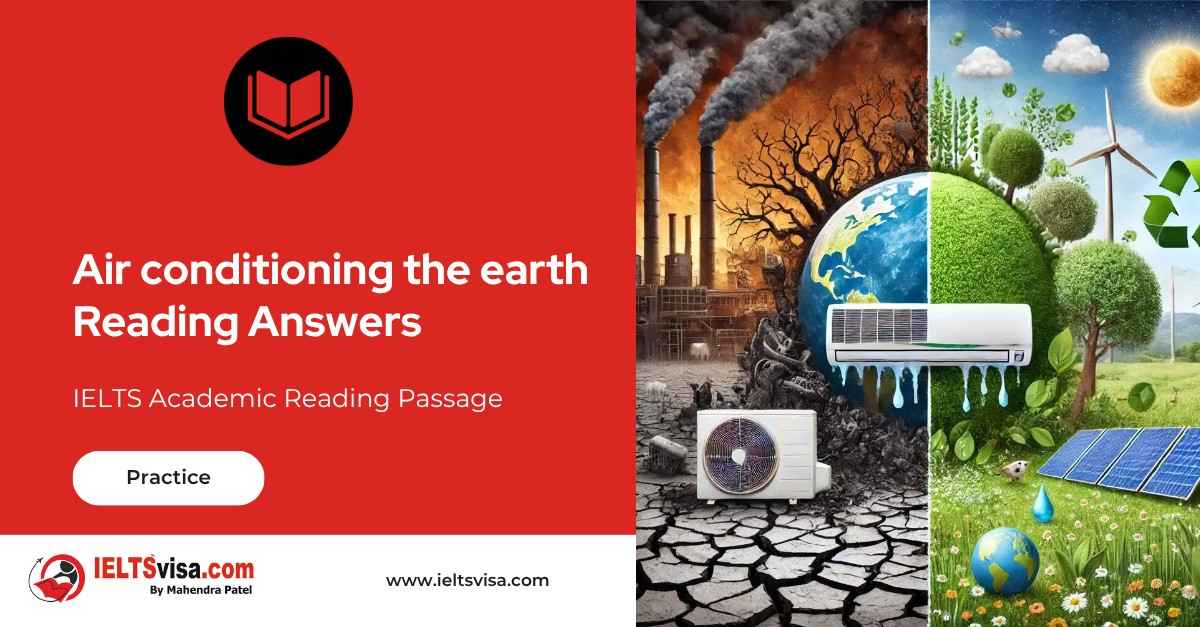Alfred Nobel: The Man Behind The Nobel Prize Reading Answer
IELTS Academic Reading Passage
A
Since 1901, the Nobel Prize has been honoring men and women from all corners of the globe for outstanding achievements in physics, chemistry, medicine, literature, and for work in peace. The foundations for the prize were laid in 1895 when Alfred Nobel wrote his last will, leaving much of his wealth to the establishment of the Nobel Prize.
B
Alfred Nobel was born in Stockholm on October 21, 1833. His father Immanuel Nobel was an engineer and inventor who built bridges and buildings in Stockholm. In connection with his construction work, Immanuel Nobel also experimented with different techniques for blasting rocks. Successful in his industrial and business ventures, Immanuel Nobel was able, in 1842, to bring his family to St. Petersburg. There, his sons were given a first-class education by private teachers. The training included natural sciences, languages and literature. By the age of 17, Alfred Nobel was fluent in Swedish, Russian, French, English and German. His primary interests were in English literature and poetry as well as in chemistry and physics. Alfred’s father, who wanted his sons to join his enterprise as engineers, disliked Alfred’s interest in poetry and found his son rather introverted.
C
In order to widen Alfred’s horizons, his father sent him abroad for further training in chemical engineering. During a two year period, Alfred Nobel visited Sweden, Germany, France and the United States. In Paris, the city he came to like best, he worked in the private laboratory of Professor T. J. Pclouze, a famous chemist. There he met the young Italian chemist Ascanio Sobrero who, three years earlier, had invented nitroglycerine, a highly explosive liquid. But it was considered too dangerous to be of any practical use. Although its explosive power greatly exceeded that of gunpowder, the liquid would explode in a very unpredictable manner if subjected to heat and pressure. Alfred Nobel became very interested in nitroglycerine and how it could be put to practical use in construction work. He also realized that the safety problems had to be solved and a method had to be developed for the controlled detonation of nitroglycerine.
D
After his return to Sweden in 1863, Alfred Nobel concentrated on developing nitroglycerine as an explosive. Several explosions, including one (1864) in which his brother Emil and several other persons were killed, convinced the authorities that nitroglycerine production was exceedingly dangerous. They forbade further experimentation with nitroglycerine within the Stockholm city limits and Alfred Nobel had to move his experimentation to a barge anchored on Lake Malaren. Alfred was not discouraged and in 1864 he was able to start mass production of nitroglycerine. To make the handling of nitroglycerine safer Alfred Nobel experimented with different additives. He soon found that mixing nitroglycerine with kieselguhr would turn the liquid into a paste which could be shaped into rods of a size and form suitable for insertion into drilling holes. In 1867 he patented this material under the name of dynamite. To be able to detonate the dynamite rods he also invented a detonator (blasting cap) which could be ignited by lighting a fuse. These inventions were made at the same time as the pneumatic drill came into general use. Together these inventions drastically reduced the cost of blasting rock, drilling tunnels, building canals and many other forms of construction work.
E
The market for dynamite and detonating caps grew very rapidly and Alfred Nobel also proved himself to be a very skillful entrepreneur and businessman. Over the years he founded factories and laboratories in some 90 different places in more than 20 countries. Although he lived in Paris much of his life he was constantly traveling. When he was not traveling or engaging in business activities Nobel himself worked intensively in his various laboratories, first in Stockholm and later in other places. He focused on the development of explosives technology as well as other chemical inventions including such materials as synthetic rubber and leather, artificial silk, etc. By the time of his death in 18%, he had 355 patents.
F
Intensive work and travel did not leave much time for private life. At the age of 43, he was feeling like an old man. At this time he advertised in a newspaper “Wealthy, highly- educated elderly gentleman seeks the lady of mature age, versed in languages, as secretary and supervisor of household.” The most qualified applicant turned out to be an Austrian woman, Countess Bertha Kinsky. After working a very short time for Nobel she decided to return to Austria to marry Count Arthur von Suttner. In spite of this Alfred Nobel and Bertha von Suttner remained friends and kept writing letters to each other for decades. Over the years Bertha von Suttner became increasingly critical of the arms race. She wrote a famous book, Lay Down Your Arms and became a prominent figure in the peace movement. No doubt this influenced Alfred Nobel when he wrote his final will which was to include a Prize for persons or organizations who promoted peace. Several years after the death of Alfred Nobel, the Norwegian Storting (Parliament) decided to award the 1905 Nobel Peace Prize to Bertha von Suttner.
G
Alfred Nobel died in San Remo, Italy, on December 10, 1896. When his will was opened it came as a surprise that his fortune was to be used for Prizes in Physics, Chemistry, Physiology or Medicine, Literature and Peace. The executors of his will were two young engineers, Ragnar Sohlman and Rudolf Lilljequist. They set about forming the Nobel Foundation as an organization to take care of the financial assets left by Nobel for this purpose and to coordinate the work of the Prize-Awarding Institutions. This was not without its difficulties since the will was contested by relatives and questioned by authorities in various countries.
H
Alfred Nobel’s greatness lay in his ability to combine the penetrating mind of the scientist and inventor with the forward-looking dynamism of the industrialist. Nobel was very interested in social and peace-related issues and held what were considered radical views in his era. He had a great interest in literature and wrote his own poetry and dramatic works. The Nobel Prizes became an extension and a fulfillment of his lifetime interests.
Questions 1-6
Do the following statements agree with the information given in Reading Passage?
In boxes 1-6 on your answer sheet, write
TRUE if the statement is true
FALSE if the statement is false
NOT GIVEN if the information is not given in the passage
1. The first Nobel Prize was awarded in
2. Nobel’s father wanted his son to have a better education than what he had had.
3. Nobel was an unsuccessful
4. Bertha von Suttner was selected by Nobel himself for the first peace
5. The Nobel Foundation was established after the death of Nobel
6. Nobel’s social involvement was uncommon in the 1800s.
Questions 7-13
Complete the notes below using NO MORE THAN TWO WORDS from the passage.
Write your answers in boxes 7-13 on your answer sheet.
Education:
Having accumulated a great fortune in his business, Nobel’s father determined to give his son the best education and sent him abroad to be trained in 7………………………….. during Nobel’s study in Paris, he worked in a private laboratory, where he came in contact with a young engineer 8…………………………. and his invention nitroglycerine, a more powerful explosive than 9………………………….
Benefits in construction works:
Nobel became really interested in this new explosive and experimented on it. But nitroglycerine was too dangerous and was banned for experiments within the city of 10 ………………….. So Nobel had to move his experiments to a lake. To make nitroglycerine easily usable, Nobel invented dynamite along with 11…………………… while in the meantime 12……………….. became popular, all of which dramatically lowered the 13………………. of construction works.

Solution:Alfred Nobel: The Man Behind The Nobel Prize Reading Answer
| 1. FALSE | 8. Ascanio Sobrero |
| 2. NOT GIVEN | 9. gunpower |
| 3. FALSE | 10. Stockholm |
| 4. FALSE | 11. detonator |
| 5. TRUE | 12. pneumatic drill |
| 6. TRUE | 13. cost |
| 7. chemical engineering |
Review and Practice
- Regularly practice with IELTS reading samples and time yourself to get used to the pressure of the exam.
- Review your mistakes to understand where you went wrong and how to avoid similar errors in the future.
Our Books
Master IELTS Speaking Part 1
IELTS Writing Task 1 Book
IELTS Writing Task 2 Book
Alfred Nobel: The man behind the Nobel Prize Reading Answer Explanation
| Question NO | Question Types | Answer | Keywords | Supporting Sentence | Location of keywords | Explanations |
|---|---|---|---|---|---|---|
| 1 | Yes / No / Not Given | FALSE | outstanding achievements in physics, chemistry, medicine, literature | Since 1901, the Nobel Prize has been honoring men and women from all corners of the globe for outstanding achievements in physics, chemistry, medicine, literature, and for work in peace | Paragraph A | The first words of paragraph A say that the Nobel Prize has been awarding men and women from all across the world for extraordinary achievements since 1901. The assertion contradicts this, so the answer is False. |
| 2 | Yes / No / Not Given | NOT GIVEN | – | – | – | It is indicated in the last line of paragraph B that Alfred’s father intended his boys to join his business as engineers. But there is no mention of Nobel’s father wanting his son to acquire a higher education than he had. Therefore, the solution is Not Given. |
| 3 | Yes / No / Not Given | FALSE | Alfred Nobel, skillful entrepreneur, and businessman | The market for dynamite and detonating caps grew very rapidly, and Alfred Nobel also proved himself to be a very skillful entrepreneur and businessman | Paragraph E | The first few words of paragraph E show the rapidly growing market for dynamite and detonating caps, where Nobel proved to be a skilled businessman. The assertion contradicts this, so the answer is False. |
| 4 | Yes / No / Not Given | FALSE | Norwegian Storting, award the 1905 Nobel Peace Prize | Several years after the death of Alfred Nobel, the Norwegian Storting (Parliament) decided to award the 1905 Nobel Peace Prize to Bertha von Suttner | Paragraph F, last line | The last sentence of paragraph F shows that the Norwegian Storting awarded the 1905 Nobel Peace Prize to Bertha von Suttner. Therefore, Nobel did not choose her for the inaugural peace prize, and the assertion is False. |
| 5 | Yes / No / Not Given | TRUE | two young engineers, Ragnar Sohlman | The executors of his will were two young engineers, Ragnar Sohlman and Rudolf Lilljequist | Paragraph G, line 3 | According to the third line of paragraph G, Ragnar Sohlman and Rudolf Lilljequist were the executors of Nobel’s will and established the Nobel Foundation to manage his finances. Therefore, the assertion is True. |
| 6 | Yes / No / Not Given | TRUE | social and peace-related issues | Nobel was very much interested in social and peace-related issues and held what were considered radical views in his era | Paragraph H | Paragraph H indicates that Nobel was very engaged in social and peace-related concerns and held what were considered radical views in his time, making the assertion True. |
| 7 | Complete the notes | chemical engineering | Alfred’s horizons, chemical engineering | To broaden Alfred’s horizons, his father sent him abroad for further training in chemical engineering | Paragraph C | According to the first few words of paragraph C, Alfred’s father sent him abroad to study chemical engineering, which expanded his horizons. Therefore, the answer is chemical engineering. |
| 8 | Complete the notes | Ascanio Sobrero | Professor T. J. Pclouze, a famous chemist | In Paris, Nobel worked in the private laboratory of Professor T. J. Pclouze, a famous chemist, where he encountered Ascanio Sobrero | Paragraph C | Paragraph C shows that Nobel worked in the private laboratory of Professor Pclouze in Paris, where he met Ascanio Sobrero, an Italian chemist who had previously produced nitroglycerine. Therefore, the answer is Ascanio Sobrero. |
| 9 | Complete the notes | gunpowder | explosive power, greatly exceeded, gunpowder | Although its explosive power greatly exceeded that of gunpowder, the liquid would explode unpredictably if subjected to heat and pressure | Paragraph C, line 6 | The sixth sentence of paragraph C states that nitroglycerine has much more explosive power than gunpowder but is highly unpredictable under heat and pressure. Therefore, the answer is gunpowder. |
| 10 | Complete the notes | Stockholm | several explosions, including one (1864) | They forbade further experimentation with nitroglycerine within the Stockholm city limits | Paragraph D, line 2 | According to paragraph D, line 2, authorities banned nitroglycerine experiments within Stockholm’s city limits after several explosions, including one in 1864 that killed his brother Emil. Therefore, the answer is Stockholm. |
| 11 | Complete the notes | detonator | lighting a fuse | To detonate the dynamite rods he also invented a detonator (blasting cap) which could be ignited by lighting a fuse | Paragraph D, line 10 | The tenth line of paragraph D explains that Nobel invented a detonator (blasting cap) that could be ignited by lighting a fuse to detonate dynamite rods. Therefore, the answer is detonator. |
| 12 | Complete the notes | pneumatic drill | pneumatic drill, same time | These inventions were made at the same time as the pneumatic drill came into general use | Paragraph D, line 11 | Paragraph D, line 11 mentions that these inventions were made around the same time that pneumatic drills became widely used. Therefore, the answer is pneumatic drill. |
| 13 | Complete the notes | cost | drilling tunnels, building canals | Together, these inventions drastically reduced the cost of blasting rock, drilling tunnels, building canals, and many other forms of construction work | Paragraph D, last line | Paragraph D’s last line shows that these inventions significantly reduced the cost of construction tasks such as blasting rock, drilling tunnels, and building canals. Therefore, the answer is cost. |
Practice IELTS Other Modules
IELTS Listening
The IELTS Listening test assesses how well you can understand spoken English in various contexts. It lasts about 30 minutes and is divided into four sections with a total of 40 questions. The listening tasks become increasingly difficult as the test progresses.
IELTS Academic Reading
The IELTS Academic Reading section assesses your ability to understand and interpret a variety of texts in academic settings. It is designed to evaluate a range of reading skills, including skimming for gist, reading for main ideas, reading for detail, understanding inferences, and recognizing a writer's opinions and arguments.
IELTS Speaking
The IELTS Speaking test assesses your ability to communicate in English on everyday topics. It lasts 11-14 minutes and consists of three parts: introduction, cue card, and a discussion based on the cue card topic.
IELTS General Reading
IELTS General Reading tests your ability to understand and interpret various types of texts. Here are some key areas and types of content you can expect to encounter in the reading section, along with tips for effective preparation.
IELTS Academic Writing Task 1
In IELTS Academic Writing Task 1, you are presented with a visual representation of information, such as graphs, charts, tables, or diagrams, and you are required to summarize, compare, or explain the data in your own words.
IELTS General Writing Task 1
In IELTS General Writing Task 1, you are required to write a letter based on a given situation. The letter can be formal, semi-formal, or informal, depending on the prompt. Here’s a breakdown of the key components to include in your letter
IELTS Academic Writing Task 2
In IELTS Academic Writing Task 2, you are required to write an essay in response to a question or topic. Here’s a guide to help you understand the essential elements of this task
IELTS Exam Tips
To succeed in the IELTS exam, practice regularly, familiarize yourself with the test format, improve your vocabulary, develop time management skills, and take mock tests to build confidence.
Grammer for IELTS
Grammar is the foundation of effective communication in English. Understanding tense usage, subject-verb agreement, and sentence structure enhances clarity and coherence in writing and speaking.
Vocabulary for IELTS
Vocabulary plays a crucial role in the IELTS (International English Language Testing System) exam, especially in the Speaking and Writing sections. Here’s an overview of why vocabulary is important and how it impacts your performance
RECENT IELTS SAMPLES QUESTIONS AND ANSWERS
Walking with dinosaurs
Peter L. Falkingham and his colleagues at Manchester University are developing techniques that...
Money as the Unit of Amount Reading Answers
The most difficult aspect of money to understand is its function as a unit of account. In...
WEATHERING IN THE DESERT
In the deserts, as elsewhere, rocks at the earth's surface are changed by weathering, which...
Nature on Display in American Zoos
The first zoo in the United States opened in Philadelphia in 1874, followed by the Cincinnati...
Can We Prevent the Poles From Melting
Such is our dependence on fossil fuels, and such is the volume of carbon dioxide we have...
Air conditioning the earth reading answers
The circulation of air in the atmosphere is activated by convection, the transference of heat...













